Iron tsuba of mokkō form (mokkōgata) pierced (sukashi) and inlaid with precast dark brass inlay (taka-zōgan) with somewhat abstract/geometrical design that can be liberally described as pines, mist, and snow.
Momoyama or early Edo period. End of the 16th - beginning of the 17th century. Heianjō school. Unsigned. Dimensions: 86.8 x 82.9 x 4.5 mm.-

-
 Iron tsuba of round form decorated with eight roundels – circular emblems of flowers and/or family crests (mon) made of cast brass, pierced and chiselled in kebori, and with flat brass inlay (hira-zōgan) of vines or leaves all over the plate. Both hitsu-ana trimmed with brass. Nakago-ana of trapezoidal form. A distinctive character of this tsuba is a mon at 6 hours depicting tomoe (comma). Yoshirō school (Kaga-Yoshirō). Attributed to Koike Yoshirō Naomasa himself. Unsigned. The Momoyama or early Edo period, end of the 16th to the first half of the 17th century (1574-1650). Size: Diameter 82.0 mm, thickness 3.8 mm at seppa-dai, 3.4 mm at rim.
Iron tsuba of round form decorated with eight roundels – circular emblems of flowers and/or family crests (mon) made of cast brass, pierced and chiselled in kebori, and with flat brass inlay (hira-zōgan) of vines or leaves all over the plate. Both hitsu-ana trimmed with brass. Nakago-ana of trapezoidal form. A distinctive character of this tsuba is a mon at 6 hours depicting tomoe (comma). Yoshirō school (Kaga-Yoshirō). Attributed to Koike Yoshirō Naomasa himself. Unsigned. The Momoyama or early Edo period, end of the 16th to the first half of the 17th century (1574-1650). Size: Diameter 82.0 mm, thickness 3.8 mm at seppa-dai, 3.4 mm at rim. -

Iron tsuba of round form decorated with eight roundels – circular emblems of flowers and/or family crests (mon) made of cast brass, pierced and chiseled in kebori, and with flat brass inlay (hira-zōgan) of vines or leaves all over the plate. Both hitsu-ana could have been trimmed with brass now lacking. Nakago-ana of triangular form, possibly enlarged, with copper sekigane. All typical emblems with bellflower, two variations on suhama theme, and 3, 4, 5, and 6-poinitng mon variations. A distinctive character of this tsuba is a mon at 12 hours depicting water plantain (omodaka).
“Omodaka was also called shōgunsō (victorious army grass); because of this martial connotation, it was a design favored for the crests of samurai families” [Family crests of Japan, Stone Bridge Press, Berkeley, California]. Yoshirō school (Kaga-Yoshirō). The Momoyama or early Edo period, beginning of 17th century. Size: Height: 81.4 mm; width: 81.2; thickness 3.8 mm at seppa-dai. -

Tsuba of oval form decorated with vines, tendrils, and leaves on trellis in brass inlay with details carved in kebori, and pierced with six family crests (mon) with two, three and four pointing stars in openwork, each outlined with brass wire and carved in kebori. Original hitsu-ana outlined with brass wire was probably enlarged later. Copper sekigane.
Momoyama to early Edo period (end of the 16th - beginning of the 17th century). Dimensions: 68.3 x 64.5 x 3.4 mm. -

Thin iron tsuba of round form pierced with six three-leaf wood sorrels (katabami) in ko-sukashi and inlaid with brass decoration along the rim. Kozuka-hitsu-ana probably cut at a later date.
Late Muromachi or Momoyama period, 16th century. Dimensions: 78.0 x 77.7 x 2.5 mm. -
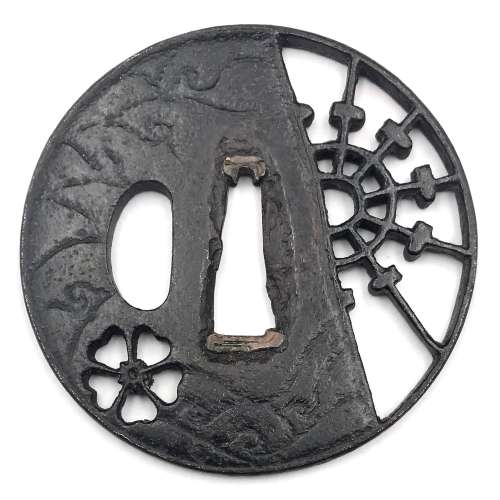 Iron tsuba of round form decorated with design of sea waves in low relief carving (kebori) and pierced with design of cherry blossom in negative silhouette (in-sukashi) and water wheel in positive silhouette (ji-sukashi). The solid portion of the plate has a shallow groove just before the edge. Copper sekigane. School attribution is unclear. Unsigned. Momoyama period, 16th - 17th century. Dimensions: Height: 70.3 mm, width: 71.1 mm, thickness at seppa-dai: 4.4 mm, at rim 4.1 mm. Provenance: Robert E. Haynes, Mark Weisman. This is what shibuiswords.com says about this tsuba:
Iron tsuba of round form decorated with design of sea waves in low relief carving (kebori) and pierced with design of cherry blossom in negative silhouette (in-sukashi) and water wheel in positive silhouette (ji-sukashi). The solid portion of the plate has a shallow groove just before the edge. Copper sekigane. School attribution is unclear. Unsigned. Momoyama period, 16th - 17th century. Dimensions: Height: 70.3 mm, width: 71.1 mm, thickness at seppa-dai: 4.4 mm, at rim 4.1 mm. Provenance: Robert E. Haynes, Mark Weisman. This is what shibuiswords.com says about this tsuba:"A very unusual iron plate tsuba. The solid plate is carved with waves on both sides. A cherry bloom in sukashi, lower left, and the right third of the plate in openwork with design of a water wheel. The rim with some iron bones. The hitsu-ana is original but the shape may have been slightly changed. One would expect this to be the work of the early Edo period, but the age of the walls of the sukashi would suggest that this is a work of the middle Muromachi period. This must be the forerunner for the Edo examples we see of this type of design." (Haynes)
I managed to find a look-a-like tsuba in Haynes Catalog #5, 1983, pp. 20-21, №44: "Typical later Heianjo brass inlay example. Ca. 1725. Ht. 7 cm., Th. 4.5 mm., $100/200".We see that the plate design of both tsuba is the same, and the only difference is the trim. It would be logical to assume that both pieces were made at about the same time, rather than 225 years apart. To be fair, let's accept that they were made in Momoyama period.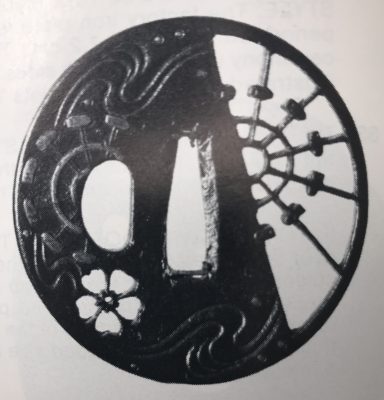
Haynes Catalog #5, 1983, pp. 20-21, №44.
-
 Ko-kinko ymagane cast tsuba of mokko form (kirikomi-mokkō-gata) with chiseled diaper pattern of double head waves on both sides and a rabbit cast and carved with its eye inlaid in yellow metal (gold or brass) on the face. Fukurin which holds together the sandwiched layers of metal (sanmai) is about 2.4 mm wide. A look-a-like tsub of oval form instead of mokko-gata is illustrated at Robert E. Haynes's Catalog #3,1982 on page 11, lot 15: "Rare design in style of Sanmai (three layers) / Wasei work. With yamagane core and heavy rim cover. The web plates are carved with double head Goto style waves and the face has a fox. The web plates were riveted at the seppadai. See Lot 4, page 8. Ca. 1350. Ht. 6.6 cm, th. 3 mm" [underscore mine]. Quality of photo is so poor that I decided not to provide it here. Muromachi (if we follow Robert) or Momoyama period. The Momoyama attribution is mostly based on a fact that "waves and rabbit" motif became most popular in Momoyama times. Size: 68.5 x 59.8 x 4.0 mm. NBTHK Certificate № 423120. This tsuba is listed at Yakiba website with the following passage: "Attributions as well as dating of this type of tsuba has been the subject debate over the years. There are those who believe these type of tsuba to be ko-Mino (early Mino School) tsuba, others believe them to be tachi-kanaguchi tsuba. Still others insist they are simply ko-kinko (early soft metal) tsuba. This tsuba was authenticated and determined to be "Ko-Kinko" by the NBTHK". Oval form tsuba with the same design can be found in this collection - TSU-0323.
Ko-kinko ymagane cast tsuba of mokko form (kirikomi-mokkō-gata) with chiseled diaper pattern of double head waves on both sides and a rabbit cast and carved with its eye inlaid in yellow metal (gold or brass) on the face. Fukurin which holds together the sandwiched layers of metal (sanmai) is about 2.4 mm wide. A look-a-like tsub of oval form instead of mokko-gata is illustrated at Robert E. Haynes's Catalog #3,1982 on page 11, lot 15: "Rare design in style of Sanmai (three layers) / Wasei work. With yamagane core and heavy rim cover. The web plates are carved with double head Goto style waves and the face has a fox. The web plates were riveted at the seppadai. See Lot 4, page 8. Ca. 1350. Ht. 6.6 cm, th. 3 mm" [underscore mine]. Quality of photo is so poor that I decided not to provide it here. Muromachi (if we follow Robert) or Momoyama period. The Momoyama attribution is mostly based on a fact that "waves and rabbit" motif became most popular in Momoyama times. Size: 68.5 x 59.8 x 4.0 mm. NBTHK Certificate № 423120. This tsuba is listed at Yakiba website with the following passage: "Attributions as well as dating of this type of tsuba has been the subject debate over the years. There are those who believe these type of tsuba to be ko-Mino (early Mino School) tsuba, others believe them to be tachi-kanaguchi tsuba. Still others insist they are simply ko-kinko (early soft metal) tsuba. This tsuba was authenticated and determined to be "Ko-Kinko" by the NBTHK". Oval form tsuba with the same design can be found in this collection - TSU-0323.
TSU-0323. Ko-kinko yamagane tsuba with waves and rabbit motif.
-
 Large and thin iron tsuba of round form (width > height) decorated with the design of a tiger sheltering in bamboo in suemon-zōgan brass inlay. A fragment of tail inlay is missing. Bamboo leaves on the reverse. According to Merrily Baird [Symbols, p. 166], tiger sheltering in bamboo symbolizes "weak giving shelter to the strong". Momoyama period. Unsigned. Dimensions: 90.8 x 91.2 x 3.4 (center), 3.1 (rim) mm. Custom wooden box. NBTHK Certificate № 4001593.
Large and thin iron tsuba of round form (width > height) decorated with the design of a tiger sheltering in bamboo in suemon-zōgan brass inlay. A fragment of tail inlay is missing. Bamboo leaves on the reverse. According to Merrily Baird [Symbols, p. 166], tiger sheltering in bamboo symbolizes "weak giving shelter to the strong". Momoyama period. Unsigned. Dimensions: 90.8 x 91.2 x 3.4 (center), 3.1 (rim) mm. Custom wooden box. NBTHK Certificate № 4001593. -
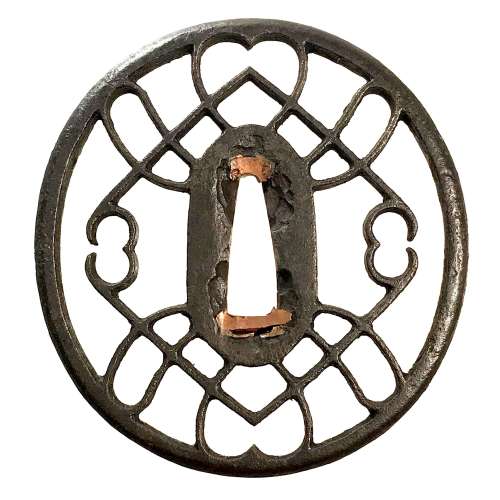 Iron tsuba of oval form with the motif of horse trappings in openwork (sukashi). Copper sekigane. Iron bones (tekkotsu) on the rim.
Iron tsuba of oval form with the motif of horse trappings in openwork (sukashi). Copper sekigane. Iron bones (tekkotsu) on the rim.Size: 80.4 x 75.8 x 5.2 mm
NBTHK Certificate №454567, allegedly saying that it is Akasaka School, Muromachi period. A look-a-like tsuba in Robert. E. Haynes Catalog #7, 1983 on page 57 under №48 is described as follows: "A masterpiece second period Owari sukashi tsuba. The plate is of beautiful color and quality almost like velvet. The design is very hard to discern, it might be the horse trappings, or even a moon. The style and type of Owari tsuba shows the great tradition of the Momoyama period and why it was the renaissance in time, as well as the arts produced, through the long history of all Japanese art. Ca. 1580. Ht. 7.7 cm, Th. (center) 5.5 mm, (edge) 5.25 to 5.75 mm."I believe we can safely attribute this tsuba to Owari School, c. 1580.
Robert. E. Haynes Catalog #7, 1983, p. 57, №48.
-
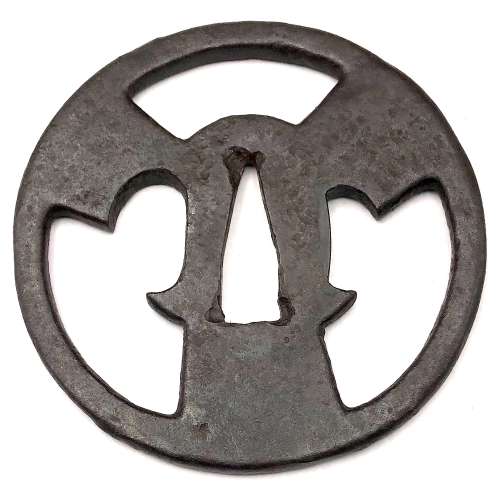 Iron tsuba of round form with three stylized folding fans motif in openwork (sukashi). Kogai-hitsu-ana with shakudō sekigane. Iron bones (tekkotsu) on the rim. Momoyama period or earlier. Possibly, Ko-Shōami school.
Iron tsuba of round form with three stylized folding fans motif in openwork (sukashi). Kogai-hitsu-ana with shakudō sekigane. Iron bones (tekkotsu) on the rim. Momoyama period or earlier. Possibly, Ko-Shōami school.Size: 76.8 x 75.7 x 4.0 mm.
[Seller alleged that the motif is "Buddhist wheel", which seems unlikely. -
 Iron tsuba of otafuku-gata form decorated on the face with death and autumn motifs: autumnal grasses and flowers in yellow brass and shakudō, skull, limb bone and sternum inlaid in shakudō. On the reverse the plate is inlaid in red copper with a chrysanthemum and maple leaves floating in stylized water streams. "Plants floating atop water form common motifs, as occurs with chrysanthemums, maple leaves, and cherry blossoms, in particular." [Merrily Baird]. Such plants may be used as a family crest (mon), or may be just a reminder of a floating nature of life. Momoyama period, late 15th century. Dimensions: 75.3 x 69.9 x 4.3 mm.
Iron tsuba of otafuku-gata form decorated on the face with death and autumn motifs: autumnal grasses and flowers in yellow brass and shakudō, skull, limb bone and sternum inlaid in shakudō. On the reverse the plate is inlaid in red copper with a chrysanthemum and maple leaves floating in stylized water streams. "Plants floating atop water form common motifs, as occurs with chrysanthemums, maple leaves, and cherry blossoms, in particular." [Merrily Baird]. Such plants may be used as a family crest (mon), or may be just a reminder of a floating nature of life. Momoyama period, late 15th century. Dimensions: 75.3 x 69.9 x 4.3 mm. -
 Iron tsuba of mokko form decorated with brass flat inlay (hira-zōgan) all over on both sits and going over the rounded rim. Black patina, well-forged iron. Hitsu-ana outlined with brass inlay. Former owner's catalogue number in red paint reads 25-17-61. Gary D. Murtha provides detailed account of this type of tsuba in Japanese Sword Guards. Onin-Heianjo-Yoshiro book on pages 118-122. He calls this type of tsuba "Heianjo Mogusa Tsuba": "The term mogusa is commonly used for an inlay design that represents an aquatic weed, similar to a duck weed or sago plant, which is known to quickly invade and overtake bodies of water. [...] Perhaps the visual image has some cross-over meaning for samurai in that, like the plant, a small aggressive samurai force could conquer a larger foe/area." I tried to find any reference to "mogusa" in literature, - to no avail. Neither on the vastness of internet, including Wikipedia... I did find the "duckweed" (one word), but visually it has nothing to do with the pattern on tsuba. "Sago plant" probably stands for 'Sago palm", and there is some very distant reminiscence in the construction of the sago palm leaf and the said design of inlay, but I would not go that far. In the old catalogues, such as Naunton and Hawkshaw collections, this pattern as called "sea weed" and/or "conventional fir". I will stick to these descriptions, tested by the time, and leave the enigmatic "mogusa" alone. Obviously, this type of tsuba has transformed into Yoshirō tsuba, both in Kaga province and Bizen province. Momoyama period (ca. 1660). Dimensions: 74.5 x 73.7 x 4.4 mm.
Iron tsuba of mokko form decorated with brass flat inlay (hira-zōgan) all over on both sits and going over the rounded rim. Black patina, well-forged iron. Hitsu-ana outlined with brass inlay. Former owner's catalogue number in red paint reads 25-17-61. Gary D. Murtha provides detailed account of this type of tsuba in Japanese Sword Guards. Onin-Heianjo-Yoshiro book on pages 118-122. He calls this type of tsuba "Heianjo Mogusa Tsuba": "The term mogusa is commonly used for an inlay design that represents an aquatic weed, similar to a duck weed or sago plant, which is known to quickly invade and overtake bodies of water. [...] Perhaps the visual image has some cross-over meaning for samurai in that, like the plant, a small aggressive samurai force could conquer a larger foe/area." I tried to find any reference to "mogusa" in literature, - to no avail. Neither on the vastness of internet, including Wikipedia... I did find the "duckweed" (one word), but visually it has nothing to do with the pattern on tsuba. "Sago plant" probably stands for 'Sago palm", and there is some very distant reminiscence in the construction of the sago palm leaf and the said design of inlay, but I would not go that far. In the old catalogues, such as Naunton and Hawkshaw collections, this pattern as called "sea weed" and/or "conventional fir". I will stick to these descriptions, tested by the time, and leave the enigmatic "mogusa" alone. Obviously, this type of tsuba has transformed into Yoshirō tsuba, both in Kaga province and Bizen province. Momoyama period (ca. 1660). Dimensions: 74.5 x 73.7 x 4.4 mm. -

Iron tsuba of round form with dam-shaped rim (dote-mimi) pierced with hitsu-ana and two udenuki-ana (probably cut later on) decorated in flat inlay (hira-zōgan) with vines and symbols of thunder or lightning (possibly - family crest, mon). Hitsu-ana and nakago-ana with copper sekigane.
Ōnin or Heianjō school, or, possibly Kaga or Umetada school. Momoyama period or earlier (Muromachi), 16th century. Unsigned.Size: 64.5 x 63.8 x 2.2 (center), 4.2 (rim) mm.
Provenance: Lundgren Collection: [Japanese sword-fittings and metalwork in the Lundgren Collection. Published by Otsuka Kogeisha Co., Ltd., Tokyo 1992], №31; The Lundgren Collection of Japanese Swords, Sword Fittings and A Group of Miochin School Metalwork. Christie's Auction: Tuesday, 18 November 1997, London. Sales "GOTO-5881". Christie's, 1997, №2. Lundgren's description at Christie's: Heianjo tsuba. Unsigned. The circular plate decorated in brass hirazogan with flowers, plants and symbols of thunder, dote mimi and udenuki ana, late Muromachi period (16th century). Tokyo 1992 description: Sword guard with design of flowering plants and frets in inlay. Unsigned. Heianjo inlay school. 6.35 x 6.3 cm, thickness of rim 0.40 cm. Iron. Flat brass inlay. Muromachi-Momoyama Period, 16th century. Provenance: The Second John Harding. A somewhat look-a-like pieces can be found in various catalogues. The one in Naunton Collection, №172, is signed: Umetada of Yamashiro: "Iron, small, almost circular, with raised oval rim, inlaid all over with leaves and scrolls in brass hirazōgan." -
 Relatively thick iron tsuba of rounded square form with slightly elevated rim decorated in carving (sukidashi-bori) and yellow brass (shinchū) inlay (suemon-zōgan) with legendary creatures (humans with cow heads) in a pine tree forrest on the face, and a horned man with a stick hunting a rabbit in the woods on the reverse. Large hitsu-ana possibly cut off later on. In the beginning of the 20th century such tsuba were usually attributed to Fushimi-Kaga school. This one may be attributed to either Ōnin or to Heianjō. The latter seems most plosible because of the thick web and dull patina. The technique may also be called "shinchū-zōgan". Momoyama or early Edo period. Unsigned. Dimensions: 72.3 x 68.4 x 4.1 mm
Relatively thick iron tsuba of rounded square form with slightly elevated rim decorated in carving (sukidashi-bori) and yellow brass (shinchū) inlay (suemon-zōgan) with legendary creatures (humans with cow heads) in a pine tree forrest on the face, and a horned man with a stick hunting a rabbit in the woods on the reverse. Large hitsu-ana possibly cut off later on. In the beginning of the 20th century such tsuba were usually attributed to Fushimi-Kaga school. This one may be attributed to either Ōnin or to Heianjō. The latter seems most plosible because of the thick web and dull patina. The technique may also be called "shinchū-zōgan". Momoyama or early Edo period. Unsigned. Dimensions: 72.3 x 68.4 x 4.1 mm -
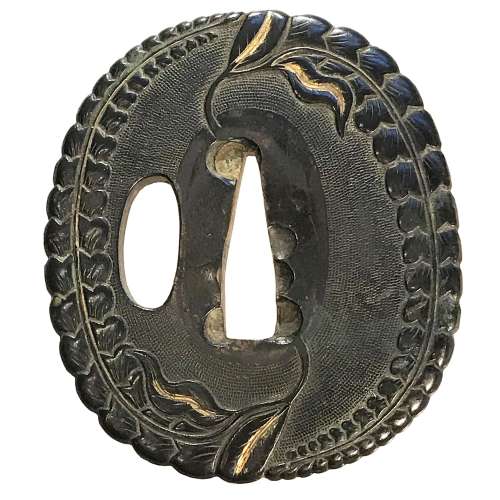
A yamagane tsuba of oval form with green-ish black patina decorated in usuniku-bori carving and gold iroe with wisteria (fuji) motif plus nanako-ji ground on both sides. Kozuka-hitsu-ana possibly cut later.
Unsigned.
Momoyama or may be even Muromachi period. Dimensions: 70.0 x 61.2 x 5.0 (center) mm -
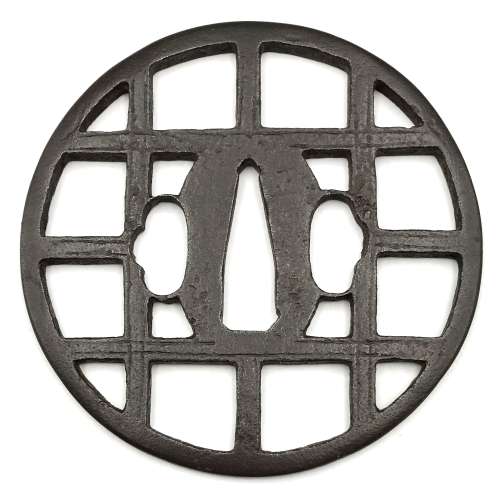 Iron tsuba of round form with design of lattice (kōshi-mon, 格子文) cut in openwork (sukashi), with low relief shallow linear carving along the bars. Well forged plate with brown-ish hue. To the right of nakago-ana there is a clear inscription of the character Shō (正), which is explained by Markus Sesko is follows: "The Shinsa obviously recognized more from the signature when having the tsuba in hand, i.e. they were confident to say it is signed "Shōami" but the rest is illegible (ika-fumei, 以下不明). That is, if they were just able to read the first character SHŌ (正) and saw that there were two more, most likely A (阿) and MI (弥), they would have put those character in boxes on the paper. Boxes around characters namely means that the character is not 100% legible but it can be assumed what it is." Momoyama or early Edo period. Dimensions: 85.9 mm diameter, 3.6 mm thickness at seppa-dai. Weight: 79 g. NBTHK certificate № 425069 with attestation: Hozon - "Worthy of preservation". A similar tsuba is presented at Japanese Sword Fittings from the R. B. Caldwell Collection. Sale LN4188 "HIGO". Sotheby's, 30th March 1994, №15. The description says: "A rare early Kamakura-bori tsuba. Nambokucho period (late 14th century). Of circular form, the dark plate carved and pierced with a gate design, the struts with double engraved lines. Unsigned. 8.5 cm." The lot was sold for 1,840 GBP.We have two possible explanations of the discrepancy between Sotheby's and Shinsa/Sesko attribution: 1) either Sotheby's or Shinsa/Sesko were wrong in their attribution or 2) these are two different pieces, one - Kamakura-bori from the 14th century and another - Shōami from 16th/17th century. Anyway, I would consider my piece as a Shōami tsuba of Momoyama - early Edo period, just for the sake of modesty.
Iron tsuba of round form with design of lattice (kōshi-mon, 格子文) cut in openwork (sukashi), with low relief shallow linear carving along the bars. Well forged plate with brown-ish hue. To the right of nakago-ana there is a clear inscription of the character Shō (正), which is explained by Markus Sesko is follows: "The Shinsa obviously recognized more from the signature when having the tsuba in hand, i.e. they were confident to say it is signed "Shōami" but the rest is illegible (ika-fumei, 以下不明). That is, if they were just able to read the first character SHŌ (正) and saw that there were two more, most likely A (阿) and MI (弥), they would have put those character in boxes on the paper. Boxes around characters namely means that the character is not 100% legible but it can be assumed what it is." Momoyama or early Edo period. Dimensions: 85.9 mm diameter, 3.6 mm thickness at seppa-dai. Weight: 79 g. NBTHK certificate № 425069 with attestation: Hozon - "Worthy of preservation". A similar tsuba is presented at Japanese Sword Fittings from the R. B. Caldwell Collection. Sale LN4188 "HIGO". Sotheby's, 30th March 1994, №15. The description says: "A rare early Kamakura-bori tsuba. Nambokucho period (late 14th century). Of circular form, the dark plate carved and pierced with a gate design, the struts with double engraved lines. Unsigned. 8.5 cm." The lot was sold for 1,840 GBP.We have two possible explanations of the discrepancy between Sotheby's and Shinsa/Sesko attribution: 1) either Sotheby's or Shinsa/Sesko were wrong in their attribution or 2) these are two different pieces, one - Kamakura-bori from the 14th century and another - Shōami from 16th/17th century. Anyway, I would consider my piece as a Shōami tsuba of Momoyama - early Edo period, just for the sake of modesty.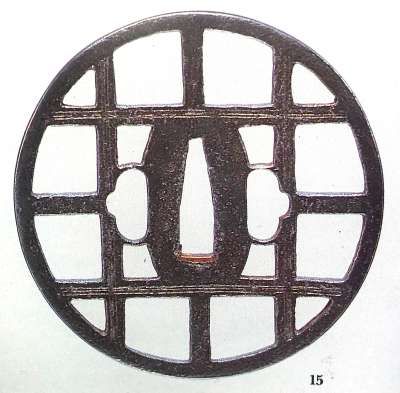
Caldwell Collection. Sotheby's 1994, №15.
-
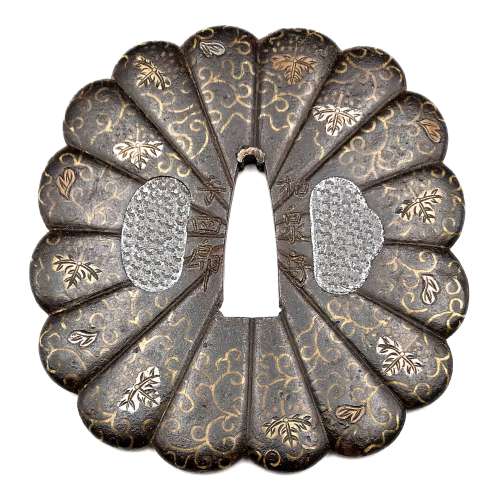 The chrysanthemoid (kiku-gata) iron plate with polished surface decorated with arabesque (karakusa) and paulownia (kiri) leaves and flowers in brass, copper and silver flush inlay (hira-zōgan) on both sides. Some of the inlay goes over the edge. Kozuka- and kogai-hitsu-ana are filled with lead plugs. Sekigane of copper. Chrysanthemum and paulownia are the symbols of imperial family. The face is signed: Izumi no Kami to the right of nakago-ana, and Yoshiro on the left; the back is signed Koike Naomasa. His signed work is considered by many experts to have been made-to-order only. The original wooden box (tomobako) with inscription (hakogaki) signed by Dr. Kazutaro Torigoye and dated Showa 39 (1964). The late Muromachi or Momoyama period, 16th century. Dimensions: 89 mm x 84 mm x 3.6 mm; Weight: 170 g. Hakogaki lid: Yoshirō kikka-gata Hakogaki lid inside: Iron, signed on the omote: Izumi no Kami – Yoshirō; on the ura: Koike Naomasa. Kikka-gata, pronounced maru-mumi, two hitsu-ana, karakusa, and kiri design in brass, silver, and suaka hira-zōgan. Height 8.5 cm, thickness 3.5 mm. Herewith I judge this work as authentic. On a lucky day in July of 1964. Torigoe Kōdō [Kazutarō] + kaō According to Robert Haynes [Catalog #7, 1983; №32, page 42-43] "This full form of the signature is seen very rarely". His example, illustrated in that catalogue, measures: height = 86 mm, thickness at seppa-dai = 3.75 mm and signed Izumi no Kami Yoshiro on the back and Koike Naomasa on the face. The further description of his specimen by Robert Haynes:
The chrysanthemoid (kiku-gata) iron plate with polished surface decorated with arabesque (karakusa) and paulownia (kiri) leaves and flowers in brass, copper and silver flush inlay (hira-zōgan) on both sides. Some of the inlay goes over the edge. Kozuka- and kogai-hitsu-ana are filled with lead plugs. Sekigane of copper. Chrysanthemum and paulownia are the symbols of imperial family. The face is signed: Izumi no Kami to the right of nakago-ana, and Yoshiro on the left; the back is signed Koike Naomasa. His signed work is considered by many experts to have been made-to-order only. The original wooden box (tomobako) with inscription (hakogaki) signed by Dr. Kazutaro Torigoye and dated Showa 39 (1964). The late Muromachi or Momoyama period, 16th century. Dimensions: 89 mm x 84 mm x 3.6 mm; Weight: 170 g. Hakogaki lid: Yoshirō kikka-gata Hakogaki lid inside: Iron, signed on the omote: Izumi no Kami – Yoshirō; on the ura: Koike Naomasa. Kikka-gata, pronounced maru-mumi, two hitsu-ana, karakusa, and kiri design in brass, silver, and suaka hira-zōgan. Height 8.5 cm, thickness 3.5 mm. Herewith I judge this work as authentic. On a lucky day in July of 1964. Torigoe Kōdō [Kazutarō] + kaō According to Robert Haynes [Catalog #7, 1983; №32, page 42-43] "This full form of the signature is seen very rarely". His example, illustrated in that catalogue, measures: height = 86 mm, thickness at seppa-dai = 3.75 mm and signed Izumi no Kami Yoshiro on the back and Koike Naomasa on the face. The further description of his specimen by Robert Haynes:"Early signed example of the work of Koike Naomasa. The kiku shape iron plate is well finished. The flush inlay is brass, for the scroll work on both sides, with the leaves and kiri mon in brass, copper and silver with strong detail carving. Some of the inlay goes almost over the edge, which is goishi gata. The large hitsuana are plugged in lead with starburst kokuin surface design. [...]The face is signed in deep bold kanji: Koike Naomasa; the back is signed: Izumi no Kami, on the right and Yoshiro on the left. There are one or two small pieces of inlay missing. Sold by Sotheby London, Oct. 27, 1981, lot 368. Height = 86 mm, thickness (seppa-dai) = 3.75 mm, (edge) = 4 mm."
Another similar example presented at: "Tsuba" by Günter Heckmann, 1995, №T55 — "Designation: Koike Naomasa. Mid Edo, end of the 17th century. Iron, hira-zogan in brass, copper, silver and shakudo, katakiri-bori. Tendrils and leaves. 87.0 x 78.0 x 4.0 mm." Reference: Japanische Schwertzierate by Lumir Jisl, 1967, page. 13. [SV: Actually, his tsuba is signed Izumi no Kami Yoshiro on the back; and Koike Naomasa on the front, exactly as Robert Haynes's tsuba. Dating this tsuba Mid-Edo, 17th century may be considered a misattribution]. More details regarding the Yoshirō tsuba. -
 Iron tsuba of round form decorated with eight roundels - circular emblems of flowers and/or family crests (mon) made of cast brass, pierced and chiseled in kebori, and with flat brass inlay (hira-zōgan) of vines or seaweed all over the plate. Hitsu-ana outlined in brass. Four positive silhouette roundels are 3-, 4-, 5-, and 6- pointing crests/flowers; four negative silhouette roundels are bellflower, cherry blossom, and suhama. Yoshirō school (Kaga-Yoshirō). The Momoyama or early Edo period, beginning of 17th century. Size: diameter 77 mm, thickness 3,8 mm
Iron tsuba of round form decorated with eight roundels - circular emblems of flowers and/or family crests (mon) made of cast brass, pierced and chiseled in kebori, and with flat brass inlay (hira-zōgan) of vines or seaweed all over the plate. Hitsu-ana outlined in brass. Four positive silhouette roundels are 3-, 4-, 5-, and 6- pointing crests/flowers; four negative silhouette roundels are bellflower, cherry blossom, and suhama. Yoshirō school (Kaga-Yoshirō). The Momoyama or early Edo period, beginning of 17th century. Size: diameter 77 mm, thickness 3,8 mm


